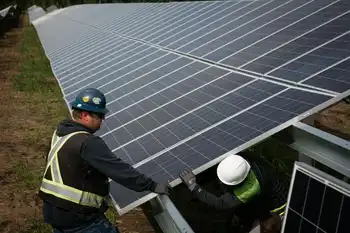Caltrain an example for GO to follow
SAN FRANCISCO, CALIFORNIA - With apologies to Charles Dickens, this is a tale of two cities' railways.
The first is Caltrain, San Francisco's commuter service. The other is Toronto's GO Transit. The issue that connects and divides these two railways is electrification.
Since they were introduced in 1895, electric trains have proved unbeatable by other forms of land transportation in terms of speed, power, energy efficiency and environmental friendliness.
Electricity powers the world's fastest passenger trains, propels its heaviest freight trains and moves millions of commuters daily in cities around the globe. Electrification is the gold standard of railroading from Brooklyn to Barcelona to Beijing.
But electrification never gained much traction in North America. The reason is simple: cheap oil coupled with relatively cheap diesel locomotives. The Achilles heel of electrification in an oil-rich society has always been its high upfront cost, which has overshadowed the long-term savings. The one place it has scored big is between Boston, New York and Washington. The line is fully electrified, highly efficient and very fast.
Now, San Francisco is taking the same route as the U.S. northeast corridor, Europe and Asia. Caltrain's future is wired into the economic, environmental and social benefits of electrifying its 74-kilometre line at a cost of $785 million. The line will also provide the San Francisco gateway for Governor Arnold Schwarzenegger's all-electric, San Diego-Sacramento high-speed passenger trains. Electrification will enable the construction and development of the air rights above a tunnelled extension to a new downtown terminal, too.
For Caltrain, electrification is its only option. Sticking with diesels to handle ridership growth will bankrupt it. Caltrain's position is they either electrify or put the diesels in the barn and shut the system down. The advantage of electrification is that the more trains you run, the better the financial picture. The harder and longer you work an electric train, the better it performs.
Caltrain's embrace of electric trains sparked interest here in Ontario at Metrolinx. This is the provincial agency formed four years ago to take over GO and solve the multiple transportation problems afflicting the region from Niagara to Durham to Lake Simcoe.
In the April 19, 2008, edition of the Star, Metrolinx vice-president of investment strategy and project evaluation, John Howe said, "[Electrification] opens up all sorts of opportunities, just like that Caltrain project. We are re-examining the whole GO Lakeshore service in terms of equipment and frequency to make it a cornerstone of our regional transportation plan. We want it to be transformational."
Bravo! That's an inspiring vision. But wait. Metrolinx is now publicly questioning whether it should electrify GO. Instead of action, the inevitable cycle of studies has begun, even though electrification has already been studied 11 times before.
A 2001 study found that GO could have converted the entire Oshawa-Hamilton line for $300 million with the locomotives and hardware from an aborted Mexican project. Premier Mike Harris's government didn't even consider it. That unused American-made equipment was scrapped.
Today, another $4 million study is chugging along. But we could really skip the study and save that public money because Metrolinx seems to have prejudged the issue.
Metrolinx executive vice-president Gary McNeil has argued that electrification doesn't add any capacity to rail lines. Wrong. That was one of the principal reasons commuter railways in New York, Philadelphia and Chicago electrified nearly a century ago. Electric trains accelerate faster than diesels and allow for more runs without track expansion. When traffic soars, as it has on many GO routes, electrification creates carrying capacity.
Metrolinx study team leader Karen Pitre has said that electric trains use more power than diesels. Also wrong. In fact, when they apply their brakes, they send electricity back into the overhead wires to help power other trains.
Pitre has also questioned the ability of overhead wires to withstand our winter weather. This will, no doubt, shock the railway managers of Scandinavia and Russia. The latter's 9,288-kilometre Trans-Siberian route is fully electrified, traversing some of the world's coldest and snowiest terrain.
There's more here than just a question of facts, arguments and the qualifications of these bureaucrats. The GO study team has revealed this will be a political decision, made at a time when a provincial election looms. Politics rears its ubiquitous head yet again. What can't be politicized is the fact that the benefits of rail electrification have been undeniable for more than a century.
The issue now sits with Premier Dalton McGuinty. If he's serious about getting people out of their gasoline-guzzling cars and onto the rails, here's his opportunity to prove it. Electrifying GO will create a climate-changing legacy for him, this city and this province.
Can we afford to? In San Francisco, the question was, "Can we afford not to?"
Worldwide experience proves it won't break the provincial piggy bank. Based on Caltrain's experience, GO's Georgetown line and the controversial Pearson International Airport spur could be electrified for about $500 million - less than half of the public cost of the G20 summit. Money would be left over to start wiring up any of GO's six other lines.
It would also scotch Toronto's dubious distinction as the only world-class city building a non-electric airport rail link.
Related News

Tories 'taking the heart out of Manitoba Hydro' by promoting subsidiaries, scrapping low-cost pledges: NDP
WINNIPEG - The board of Manitoba Hydro is being reminded it can divvy up some of the utility's work to subsidiaries — which the NDP is decrying as a step toward privatization.
A sentence seemingly granting the board permission to create subsidiaries was included in the board's new terms of reference, which the NDP raised during question period Wednesday.
The document also eliminated references asking Manitoba Hydro to keep electricity rates low and supply power in an environmentally-friendly fashion.
NDP raises spectre of Manitoba Hydro's privatization with new CEO
"They're essentially taking the heart out of Manitoba Hydro," NDP leader Wab Kinew said.
Cheap,…




